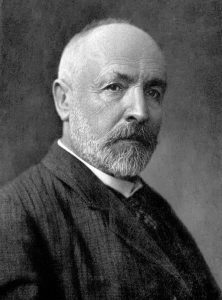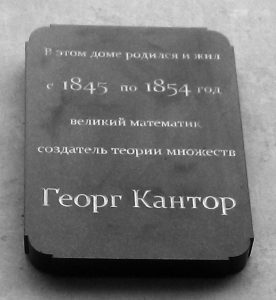
Georg Cantor was a German mathematician who was born and grew up in Saint Petersburg Russia in 1845. He helped develop modern day set theory, a branch of mathematics commonly used in the study of foundational mathematics, as well as studied on its own right. Though Cantor’s ideas of transfinite numbers are now commonly accepted and taught, they were initially very controversial and were met with harsh criticism from some of his contemporaries, (most notably Leopold Kronecker and Ludwig Wittgenstein). It is perhaps partly due to these fierce criticisms that Cantor began to suffer bouts of depression in his later life, sometimes causing him to take hiatuses from his mathematical work. In contrast to then, his work is widely considered central to higher mathematical theories such as real analysis, topology, and algebra and has received wide recognition, with the Royal Society awarding him its Sylvester medal in 1904.
Childhood and later studies: Georg Cantor was born in 1845, Saint Petersburg Russia, the son of Woldemar Georg Cantor, a successful merchant, and Marie Bohme. Georg was considered an excellent violinist as a child and has some musical roots on his mother’s side, (both his great uncle and grandfather were well known violinists, with his grandfather, Franz Bohm, performing with the Russian Imperial Orchestra). In school, Cantor showed remarkable skill in mathematics, but his father disapproved instead believing he should become an engineer. In 1856, Cantor’s father became severely ill, forcing the family to move from Russia to Germany, (due to the severely cold winters in St. Petersburg), where Cantor would spend the remainder of his life.
Later academic life in Germany: The years between 1856 to 1867 saw Cantor attending numerous Universities, culminating in receiving his doctorate degree in Mathematics at the University of Berlin in 1867. In 1869, Cantor was hired to the University of Halle, where he would spend the remainder of his career, and later promoted to full professor in 1879. It was between the years of 1874 to 1884 that Cantor worked on and published his monumental work on transfinite set theory, (for more details, see Cantor’s transfinite numbers below), though his initial publications were met with considerable backlash, the most prominent being Leopold Kronecker. Kronecker, a well established mathematics professor and one of Cantor’s former professors, utilized everything at his disposal to hinder or discredit Cantor: when Cantor submitted his first paper for publication in 1874, Kronecker deliberately delayed its publication; whenever Cantor would apply for a position at the University of Berlin, Kronecker would usually find a way to hinder his acceptance. In addition, Kronecker publicly attacked Cantor, describing him at times as a “scientific charlatan”, a renegade and a “corrupter of youth”. Eventually, the criticism of Cantor’s mathematical work weighed so heavily on him that on 1884, he suffered his first bout of depression. He took a short break from mathematics lecturing instead on philosophy and studying Baconian theory, eventually recovering and resuming his mathematical studies. In 1897, he helped establish the first International Congress of Mathematics in Zurich, Switzerland.
Later life: In 1899, Cantor suffered a second bout of depression and had to be hospitalized. It was not long after that his youngest son Rudolph tragically died on December 16. Cantor would struggle with criticism and depression for the remainder of his life. He lived long enough to see the eventual public recognition of his work; in 1904 he was awarded the aforementioned Sylvester medal by the Royal Society and was one of the distinguished scholars invited to attend the 1911 opening of the University of St. Andrews in Scotland. Cantor hoped to meet the mathematician Bertrand Russell, whose recently co-published work with Alfred Whitehead, Principia Mathematica, utilized Cantor’s work, but unfortunately this did not come about. On June 1917, Cantor checked into a sanitarium for a final time where he sadly died of a heart attack on January 6, 1918.
His work on transfinite set theory is now widely accepted in modern mathematics and taught serves as the basis for many higher level branches of mathematics.

Cantor’s transfinite numbers:

We now briefly explain some of the revolutionary concepts of Cantor’s transfinite set theory. A set is simply a collection of mathematical objects; for example the following are all sets:
{1, 2, 3} {0, 0.9, 0.99, … }
{5, 1, 7, 9} {x: x < 3 } etc.
We will denote the set of natural numbers by N, the set of integers by Z, and the set of real numbers by R. Prior to Cantor’s work, set theory was considered a rather elementary theory utilized on a surface level but never explored in its own right. The concept of infinity was considered “equinumerous”, that is there was only one “infinity” and it had only one “size”, so people believed that N and R had the same “size” because they were infinite. Cantor disproved this idea of an equinumerous infinity, proving that there was a hierarchy of infinities that continued infinitely. Cantor achieved this by extending the concepts of cardinality and order type to infinite sets. For the purposes of brevity, only the concept of cardinality will be discussed, links to more information on ordinal and cardinal numbers are provided in the references section.
The cardinality of a set is simply the amount of things that set contains, for instance the set {1, 2, 3, 4} has cardinality four since there are four things contained in it. Two sets have the cardinality when they have the same amount of things in them, for instance the sets {1, 2, 3} and {4, 5, 6} have the same cardinality of three. Cantor extended the definition of cardinality to infinite sets by utilizing functions like so:
Suppose A and B are sets, then they are said to have the same cardinality if and only if there exists a bijective function which maps A onto B.
Utilizing this new definition, we can now compare the cardinalities of infinite sets and as an example will show that N has the same cardinality as Z:
Consider the function f: N -> Z defined by f(n) = (-n – 1)/2 for odd n and f(n) = n/2 for even n. That is:
f(0) = 0
f(1) = -1
f(2) = 1
f(3) = -2
f(4) = 2
etc.
One can show that the above defined function f is bijective, so it follows that N has the same cardinality as Z.
Using this new definition, Cantor was able to prove that the cardinality of R was actually bigger than N by his famous diagonal argument, thus showing that infinity was not equinumerous as people initially believed. We will end this section by briefly mentioning Cantor’s theorem, which states that for any set X, the cardinality of its powerset P(X) is greater than the cardinality of X, in symbols: |X| < |P(X)|.
Applying Cantor’s theorem to the set N, we construct a new set P(N) whose cardinality is greater than N. But since N is an infinite set, this means that we just constructed a bigger infinity. Repeatedly applying Cantors theorem we obtain the following hierarchy of infinities:
|X| < |P(X)| < |P(P(X))| < |P(P(P(X)))| < …
Thus we have a hierarchy of infinities that goes on infinitely, absolutely mind-blowing.
References:
- Cantor’s life:
-
- https://en.wikipedia.org/wiki/Georg_Cantor#cite_note-13
- https://www.bbvaopenmind.com/en/science/mathematics/georg-cantor-the-man-who-discovered-different-infinities/
- https://www.britannica.com/biography/Georg-Ferdinand-Ludwig-Philipp-Cantor
- https://www.sciencedirect.com/topics/mathematics/georg-cantor
- https://uh.edu/engines/epi1484.htm
-
- More on Ordinal and Cardinal numbers:
-
- https://www.youtube.com/watch?v=pSSsZLTMDq0 – “Ordinal numbers vs Cardinal numbers (and how many algebraic numbers are there?)”
- https://www.youtube.com/watch?v=SrU9YDoXE88 – “How To Count Past Infinity”
- https://www.youtube.com/watch?v=elvOZm0d4H0 – “Infinity is Bigger than you think – Numberphile”
-